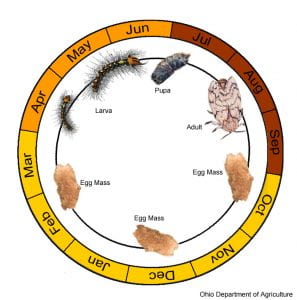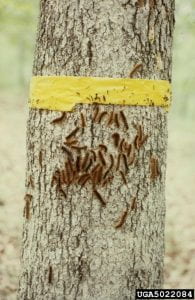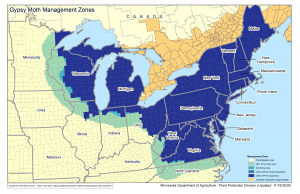By Karen McCarthy, Newburgh Master Gardener Volunteer
This article appeared in the May 2021 Issue of Gardening in Orange County.
 Years ago, hiking with friends in Orange County in July, we noticed something was “off.” It was too bright in the forest, and we heard a sound like rain. Looking up, we realized we were in an area infested with gypsy moth caterpillars that had eaten most of the leaves, creating more light than shade. The sound we heard was falling caterpillar excrement. A ruined hike!
Years ago, hiking with friends in Orange County in July, we noticed something was “off.” It was too bright in the forest, and we heard a sound like rain. Looking up, we realized we were in an area infested with gypsy moth caterpillars that had eaten most of the leaves, creating more light than shade. The sound we heard was falling caterpillar excrement. A ruined hike!
The gypsy moth (Lymantria dispar) is native to Europe and was introducedto the United States in 1868 by a French scientist in Massachusetts hoping to breed a silk-spinning caterpillar that was resistant to disease. Some of his moths escaped and are now found as far west as Minnesota and as far south as South Carolina.
The gypsy moth is one of the most important forest pests in our area as the larvae gorge themselves on shrub and tree leaves, leaving them bare and susceptible to disease. They cause millions of dollars of damage every year. They will feed on a wide variety of tree species, but prefer oaks, apples, birches, poplars, and willows.
 Lifecycle
Lifecycle
Gypsy moths spend most of the year as eggs. These egg masses can contain 500 to 1000 eggs and can be found on trees, firewood, outdoor household items, mobile homes, etc . Depending on the weather, in our area gypsy moth eggs will hatch in late April or early May.
Once the larvae emerge, they begin to move upwards into the canopy of a tree. Some larvae will stay in that tree to complete their lifecycle while others will spin a long silken thread and suspend themselves in the air waiting for a strong wind the carry to another tree; this is know as ‘ballooning.’ Once the ballooning larvae settle on a new host it will begin feeding.
 In June or early July, gypsy moth caterpillars will stop feeding and pupate. Two weeks later they will emerge as adults. Male moths are brown with black markings while female moths are white with black markings. Female moths do NOT fly which means that ballooning larvae is one of the most important means of dispersal. Of course humans also play a large role in the dispersal of this invasive species. A great time to remind you: “Don’t Move Fire Wood!”
In June or early July, gypsy moth caterpillars will stop feeding and pupate. Two weeks later they will emerge as adults. Male moths are brown with black markings while female moths are white with black markings. Female moths do NOT fly which means that ballooning larvae is one of the most important means of dispersal. Of course humans also play a large role in the dispersal of this invasive species. A great time to remind you: “Don’t Move Fire Wood!”
 Adult gyps moths do not eat and are only around for about two weeks. Males usually emerge first and wait for the females, who put out a pheromone to attract them. After mating the females lay eggs and then die.
Adult gyps moths do not eat and are only around for about two weeks. Males usually emerge first and wait for the females, who put out a pheromone to attract them. After mating the females lay eggs and then die.
Management
Overwintering egg masses can be scraped off trees and destroyed before they hatch in late April and early May. Young caterpillars,
less than one inch in length, can be killed using the biopesticde Bacillus thuringiensis (Bt). When using any pesticide read and follow all the instructions on the label!
 Once caterpillars hatch they climb up the tree in search of food, so tree bands made of duct tape with the sticky side out or another nonporous material smeared with a stick substance can be used to trap them. For a severe infestation you may need to contact a local arborist. Find one at https://www.treesaregood.org/. Repeated annual defoliation can result in the death of a tree.
Once caterpillars hatch they climb up the tree in search of food, so tree bands made of duct tape with the sticky side out or another nonporous material smeared with a stick substance can be used to trap them. For a severe infestation you may need to contact a local arborist. Find one at https://www.treesaregood.org/. Repeated annual defoliation can result in the death of a tree.
‘Fun’ Facts
One two-inch gypsy moth caterpillar can consume up to one square foot of foliage every 24 hours.
In places where there are 250 or more egg masses per acre, larvae can defoliate the infested trees.
Ballooning gypsy moth caterpillars can travel up to mile.
 In Ohio, where gypsy moths have not yet established themselves throughout the state, they deploy 12,000 gypsy moth traps across the state to monitor movement and evaluate, detect or delineate newly established colonies.
In Ohio, where gypsy moths have not yet established themselves throughout the state, they deploy 12,000 gypsy moth traps across the state to monitor movement and evaluate, detect or delineate newly established colonies.
To National Gypsy Moth Slow the Spread Program is one of the world’s largest and most successful integrated pest management programs.
Resources
Gypsy Moth – NYS Department of Environmental Conservation
Gypsy Moth – University of Massachusetts Amherst
Gypsy Moth Forecast – National Phenology Network
National Gypsy Moth Slow the Spread Program
VIDEO: Gypsy Moth in New York 2021 – Cornell University
